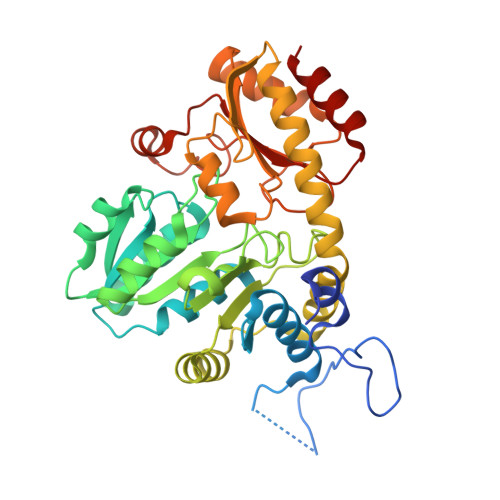Structural characterization of cystathionine gamma-lyase smCSE enables aqueous metal quantum dot biosynthesis.
Wang, Y., Chen, H., Huang, Z., Yang, M., Yu, H., Peng, M., Yang, Z., Chen, S.(2021) Int J Biol Macromol 174: 42-51
- PubMed: 33497694
- DOI: https://doi.org/10.1016/j.ijbiomac.2021.01.141
- Primary Citation of Related Structures:
6K1L, 6K1M, 6K1N, 6K1O - PubMed Abstract:
The development and utilization of inorganic material biosynthesis have evolved into single macromolecular systems. A putative cystathionine γ-lyase of bacteria Stenotrophomonas maltophilia (smCSE) is a newly identified biomolecule that enables the synthesis of nanomaterials. Due to the lack of structural information, the mechanism of smCSE biosynthesis remains unclear. Herein, we obtain two atomic-resolution smCSE-form X-ray structures and confirm that the conformational changes of Tyr108 and Lys206 within the enzyme active sites are critical for the protein-driven synthesis of metal sulfide quantum dots (QDs). The structural stability of tetramer and the specificity of surface amino acids are the basis for smCSE to synthesize quantum dots. The size of QD products can be regulated by predesigned amino acids and the morphology can be controlled through proteolytic treatments. The growth rate is enhanced by the stabilization of a flexible loop in the active site, as shown by the X-ray structure of the engineered protein which fused with a dodecapeptide. We further prove that the smCSE-driven route can be applied to the general synthesis of other metal sulfide nanoparticles. These results provide a better understanding of the mechanism of QD biosynthesis and a new perspective on the control of this biosynthesis by protein modification.
Organizational Affiliation:
Guangdong Provincial Key Laboratory of Biomedical Imaging, The Fifth Affiliated Hospital, Sun Yat-Sen University, Zhuhai 519000, Guangdong, China.














